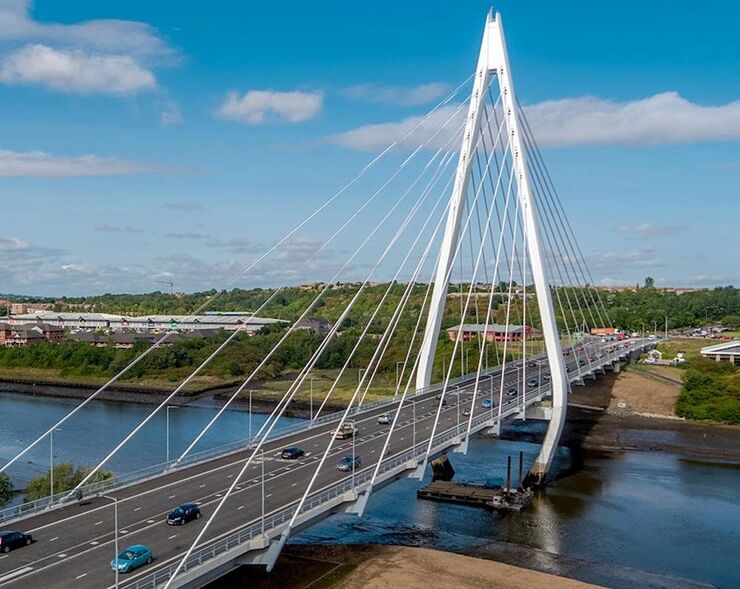
The Northern Spire is a new road crossing over the River Wear in the city of Sunderland, north-east England. Successfully delivered on budget in August 2018, it was the first bridge built over the tidal river in 44 years and has since become a high-profile regional landmark.
The new crossing helps to relieve congestion on the city’s existing Wearmouth and Queen Alexandra bridges downstream. In particular it provides a much-needed additional link between the A1/A19 strategic road network and Nissan’s Sunderland plant – Britain’s biggest car factory – to the west, Sunderland city centre and the Port of Sunderland to the east.
The Northern Spire is also supporting the city’s new 150ha International Advanced Manufacturing Park enterprise zone, which is just north of the Nissan factory, as well as helping to regenerate the riverside area and create thousands of new jobs.
Anglo-Belgian contractor
Client Sunderland City Council let the £117 million design and build project to an Anglo-Belgian joint venture of Farrans Construction and Victor Buyck Steel Construction under an NEC3 Engineering and Construction Contract (ECC) Option A (priced contract with activity schedule) in May 2015. Engineering design was subcontracted to Buro Happold and Roughan O’Donovan under an NEC3 Professional Services Contract (PSC). Atkins, part of SNC Lavalin Group, was appointed NEC project manager and supervisor under a PSC option E (time-based contract).
The project involved building a 336 m long cable-stayed bridge with a single 105 m tall central A-frame pylon, plus 3km of new highways and major roadworks. The bridge now carries the A1231 dual two-lane carriageway plus dedicated cycle and pedestrian lanes between Southwick and Pallion industrial estates on the north and south banks respectively.
The 1550t steel pylon was made off-site by Victor Buyck in Ghent and barged directly to the bridge site, where it was raised onto its piled foundations. The 4750t steel-concrete composite bridge deck was then launched from the south bank supported on temporary trestles in the river.
Part funded with a £82.5 million government grant, the iconic bridge opened to traffic in August 2018. It won the ICE 200 Special Project Award at the Institution of Civil Engineers North East’s 2018 Robert Stephenson Awards and was shortlisted for the 2018 British Construction Industry Awards.
Encouraging collaboration
Sunderland City Council project director David Abdy says, ‘We chose NEC primarily to encourage a collaborative and cooperative approach within the project team but with clear lines of responsibility and governance. The NEC suite’s widespread use throughout the UK construction market was also a key consideration over other forms of contract, ensuring familiarity throughout the supply chain.’
He says the council felt the NEC3 ECC Option A form was best suited to delivering the scale and complexity of the works, with major construction operations in a fast-flowing tidal river. ‘NEC demands a collaborative approach to managing risk and change in an efficient way. There is also a particular emphasis on effective programming, which is the primary tool for determining the share of responsibility for any delays and disruption.’
Abdy says collaborative working was evidenced by the rapid resolution of programme issues raised as NEC early warnings. ‘A proactive approach was taken by all to help to identify any potential changes as early as possible to reduce their impact. For example, we collectively decided to recycle asbestos-contaminated waste found on site, significantly reducing the costs involved in moving and processing this off-site.
‘Also, towards the end of the project, adverse weather conditions in the winter of 2017/2018 delayed the pylon painting and road surfacing works by four months. The robust project controls in NEC helped to ensure the project remained within budget.’
Benefits of using NEC
- NEC ECC Option A was well suited to the scale and complexity of the works and familiar to the supply chain.
- NEC requirement to work in a ‘spirit of mutual trust and co-operation’ encouraged collaboration, with the client and contractor working together to manage risk and change efficiently.
- NEC’s robust project controls and governance helped to ensure quality, save costs, encourage ongoing settlement of disputes and improve outturn cost forecasting.




